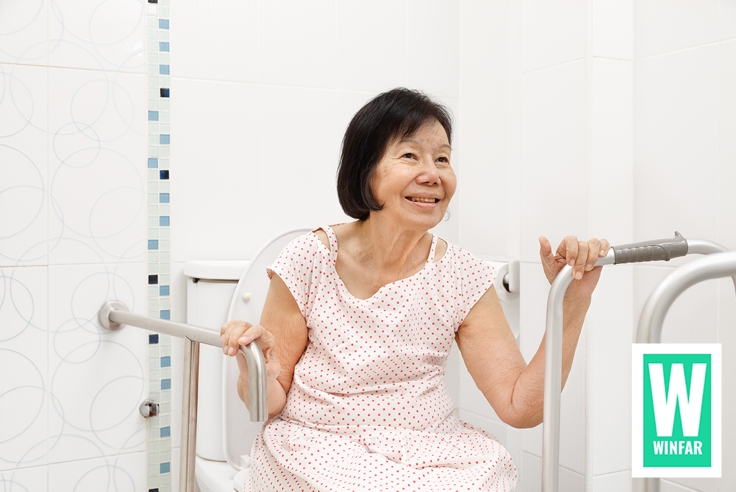Did you know that people use the toilet 7 times a day on average? And that this figure, increases as we age! Did you know that up to 80% of all falls occur in the bathroom? Conclusion: Bathroom safety is absolutely critical. Especially for Seniors. Bathrooms are dangerous places. They’re small, and cramped with lots of hard surfaces and corners. On top of that, as you age, sitting down and standing up can cause dizziness or unsteady balance, as blood pressure changes, especially for seniors – which could easily result in a fall. Balance issues, weakness, frailty, and cognitive issues, like dementia can make simple bathroom activities difficult, even dangerous. It’s important therefore that we do what we can to make the process as stress-free, safe, and unthreatening as possible. Here are a few simple tips and modifications that will make going to the bathroom safer, easier, and less stressful.
Bathroom safety tips for seniors. Questions to ask yourself.
Enroute to the bathroom:
Q1: Is the path to the bathroom clear and unobstructed?
Remove any clutter, rugs, or floor mats along that path.
Q2: Is there automatic night lighting from the bed to the bathroom? Is the pathway properly lit?
Be sure to keep the pathway to the bathroom clear at all times. Ensure the area is well-lit to minimize the chances of tripping. Simple, inexpensive plug-in night lights that automatically turn on when the area is dim, or sensor lights, that switch on when motion is detected are hugely beneficial.
In the bathroom:
Q3: Is the bathroom itself well lit? And the light switch easy to find?
Just as you want to make sure there’s enough light on the way to the bathroom, you want to ensure there is plenty of light in the bathroom.
Q4: Are there loose objects lying around on the surface tops or on the floor?
Keep the area as clean and decluttered as possible. Everything that is not essential, should be out of the way. Towels, toilet paper, extra toilet paper, washcloths, toothbrush, and toothpaste should be within easy reach. If anything requires the use of a step stool or straining to grab, find a new place for it within easier reach.
Q5 : Do they have a place to sit while at the sink?
From brushing their teeth to putting on makeup and fixing their hair, a well-placed seat reduces the standing times and the risk of a fall. However, you will need to ensure the bathroom is large enough to accommodate seating. Adding a chair to an already confined space only creates an additional hazard.
The floor:
Q6 : Keep the floor dry – at all times!
This may sound obvious, but you would be surprised. Wet or damp floors are a hazard to anyone. Be sure the bath mats you use soak up the wet. Don’t use throw mats, as these slip and bunch up easily. Use rugs or mats with grips so they don’t become a tripping hazard
The shower:
Q7: Is your bath tub and shower floor non-slip?
Having a non-slip bathmat inside the tub or shower is crucial. It gives the feet traction when you move around. When you step out of the tub, have a secured bath mat to dry your feet and keep the floor from getting wet—a microfiber mat is a good option! Alternatively, there are really excellent non-slip spray products on the market, which are highly rated and work better than most stick-on products and suction mats.
Q8 : Are there safety bars inside the shower or bath?
An essential to help seniors stand and maneuver around with ease.
Q9 : Are the doors made of breakable glass?
If so, consider replacing it with safety glass or plastic? In the case of a fall in the shower, a door made of glass may cause additional serious injuries of them being cut by glass in the fall.
Q10 : Do you have a shower bench or chair in the shower?
Reduce the stress and risk of standing in a shower with a shower chair or bath chair There are different options to accommodate your needs. Chairs have regular-sized or wider seats, swivel, height adjustable,with backs, and without backs, wall-mounted and much more. Just make sure when adding a seated spot in the shower that you can still easily reach the showerhead. This can be solved with a showerhead attachment, which reduces the need to reach or twist.
Q11: Is there an adjustable hand-held shower head?
If you take showers, a hand-held showerhead is very important! It allows easy control and minimizes movement. Also, if you’re using a bath or shower chair, it allows more flexibility to wash the hard-to-get spots at ease, without struggling or fearing you might slip or fall. These convenient shower heads allow seniors the flexibility of choice, to stand or to sit safely while showering. They’re also quick and easy to install.
Q12 : Weighted Shower Curtain
Also, an important tip to remember is that whether you’re taking a bath or shower, water might splash outside of the bathtub, so it’s best to use a weighted shower curtain so it doesn’t get the bathroom floor wet!
Q13: Are all the essentials within easy reach? And easy to use.
Inside the cubicle, ensure everything you need is easy to reach and within arms reach. Dispensers may be a good idea, as these are easy to refill and use, without the risk of twisting, bending down, and potentially slipping or straining yourself.
Toilet
Q14: Are there properly installed grab bars and toilet safety add-ons?
Have they the needed assistance to get on or off the toilet independently? Adding wall-mounted grab bars around the toilet area, increases support when sitting and standing. An additional consideration is a raised toilet seat. If they are having difficulties using the toilet, you may find a raised toilet seat a useful aid. Raised toilet seats are available with or without arms. With arms reduces the effort and distance to sit and stand, when using the toilet. Download FULL SAFETY CHECKLIST HERE

